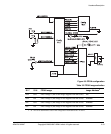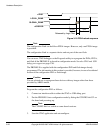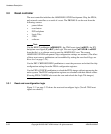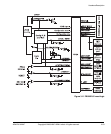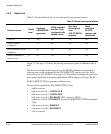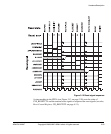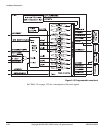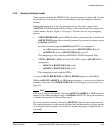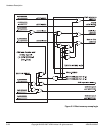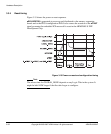
Hardware Description
ARM DUI 0224F Copyright © 2003-2007 ARM Limited. All rights reserved. 3-27
3.3.3 Memory aliasing at reset
Under normal operation, the PB926EJ-S has dynamic memory located at
0x0
. In order
to load the boot code however, non-volatile memory must be remapped to the boot
address.
Remapping the memory is done by changing how the chip select signals in the
ARM926EJ-S PXP Development Chip connect to the external chip select signals that
control memory devices. Figure 3-14 on page 3-28 shows the two stage remapping
process:
•If DEVCHIP REMAP signal is HIGH, from the system controller, it disables the
nMPMCDYCS0 signal that is normally generated by accesses to memory region
0x00000000
–
0x03FFFFFF
.
Accesses to memory region
0x00000000
–
0x03FFFFFF
are remapped to:
— the AHB expansion memory chip select if BOOTCSSEL[1:0] is
b11
— nSTATICCS1 if one of BOOTCSSEL[1:0] is not
b11
.
This remapping occurs inside the ARM926EJ-S PXP Development Chip.
•If FPGA_REMAP is HIGH, from the SYS_MISC register, nSTATICCS1 is
remapped to:
— nDOCCS if BOOTCSSEL[1:0] is
b00
— nNORCS if BOOTCSSEL[1:0] is
b01.
This remapping occurs inside the FPGA.
At reset, the DEVCHIP REMAP and FPGA_REMAP signals are both HIGH.
Which of nDOCCS, nNORCS, or AHB expansion memory is active at reset therefore
depends on the value of the BOOTCSSEL[1:0]. See Remapping of boot memory on
page 4-9.
Note
If the size of the physical memory selected by nDOCCS, nNORCS, or AHB expansion
memory is less than the address range of
0x00000000
–
0x03FFFFFF
, the physical memory
is aliased and repeated to fill the address space.
The static expansion memory selected by nEXPCS2 cannot be used as boot memory.
The expansion memory can be moved to address
0x0
, but the memory no longer appears
at its original location and the code in the boot monitor that jumps to high memory is
not usable.



